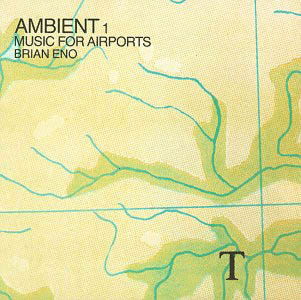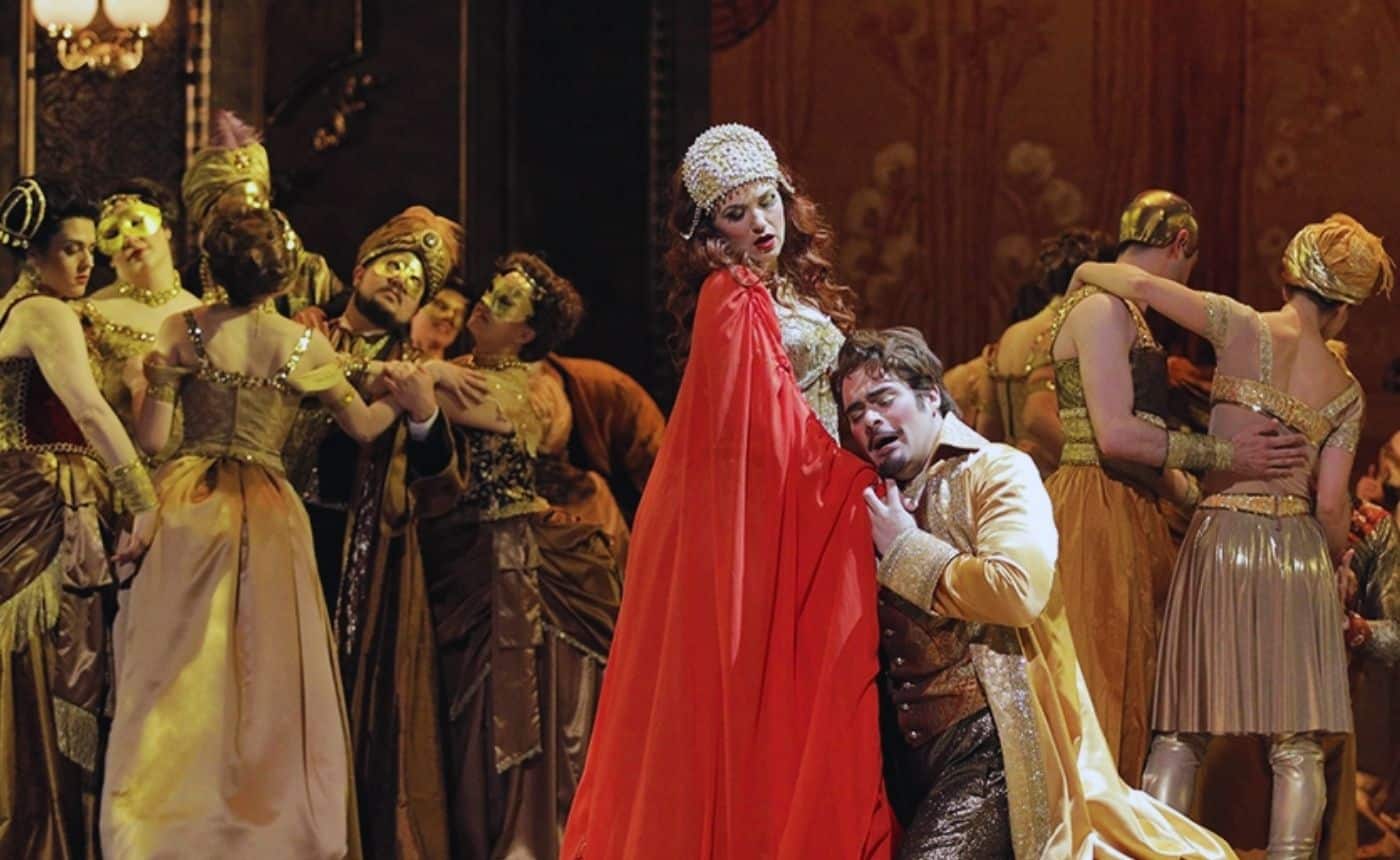Flight online course by Ross HagenPart 2: Music for Airports
While Flight may be the first opera to be set in an airport to my knowledge, the experiences of travel have long been an inspiration for composers, artists, and writers. However…there is definitely something singular about the modern airport that provides a lot of grist for the artistic and creative mill. Part of it is of course the human experience. One of the more affecting pieces of video art I have ever encountered was a piece entitled “Wait” that I saw in a small modern art museum in the UK in the late 1990s. It consisted of three projectors each playing about a ten-minute loop of film, slightly slowed down, observing people waiting at an airport gate for someone to arrive (back when you could do that) and then capturing their glee when the person came out of the jetbridge. But in some cases it’s also the very nature of the airport as a location that can be inspiring.
“Music for Airports” is the subtitle of Ambient 1, the 1978 album by the composer Brian Eno that became the first album to self-consciously apply the term “ambient music.” Eno’s inspiration for the album was, somewhat paradoxically, the absolutely characterless atmosphere of airports, which seemed to him to exacerbate the anxious and monotonous experience of air travel. To be sure, there was background music in airports, but it was the derivative and lifeless Muzak smooth jazz “canned music” that had become ubiquitous in retail spaces in the 70s and 80s. Ambient 1: Music for Airports, on the other hand, was an original composition made up of layered tape loops in evolving patterns, that was not intended to brighten the mood but rather to induce calm and meditation while also being, in Eno’s words, “as ignorable as it is interesting.” The initial idea of using the album as a looping sound installation was realized in the mid-1980s when it was played on loop in one of the terminals at LaGuardia in New York. Unfortunately it was apparently not very well-appreciated.

Although Eno’s ambient works have seemingly little to do with Flight, they both take their inspiration from the unique qualities of airports and other transitory spaces. Places like airports, bus and train stations, and hotels are what we might call “liminal” spaces, meaning that they sit at a boundary or threshold. They are designed for people to move through enroute to other destinations. As a result, they have a unique sort of emotional character or aura to them, a mix of anxiety, hope, and perhaps a certain tired resignation. The people one might typically meet in an airport or on a flight are what the narrator in Fight Club referred to as “single-serving friends,” who require no further investment or obligation. While this aspect could seem somewhat depressing, there is perhaps a liberatory side to it as well. The lack of further obligation means that single-serving conversations can become quite personal and even revelatory, an experience that I imagine many of us have had at one point. In some cases, you run into people who are in the midst of serious life changes and momentous decisions. Flight accentuates this further by denying proper names to most of the characters, instead identifying them by their job, immigration status, age, or destination.
Further, airports might serve a city or a metropolitan area, but their very nature often ensures that they remain geographically distant from central urban areas, while major train and bus stations typically deposit travellers right into the heart of a city. If you’re flying into New York City, after you land you still likely have an hour or more of trains, buses, and/or taxis before arriving at your destination. Closer to our part of the country, if you walk out the doors of Denver International Airport you’re faced with empty prairie for at least 10 miles in any direction. So an airport is not only a transitory space, but it is also often isolated and remote.
Dove’s Flight takes advantage of this unmoored quality, and in doing so it joins a rich tradition of storytelling that mines the temporary nature of the relationships formed in “liminal” or transitory locations. Looking back into literature, the obvious model for this would likely be The Decameron by Giovanni Boccaccio, a mid-14th century work that is framed as a collection of stories told by ten young Florentines over ten nights taking refuge from the Black Death in the country, with the stories of each night addressing a particular topic or story type. The framing of The Decameron within the context of a plague naturally made it the subject of much commentary in 2020, but while the collection’s introduction addresses the plague scenario, it recedes into the background once the series of 100 stories begins. Following the stories, the storytellers all return to their homes, and Boccaccio’s postscript addresses readers directly in an attempt to provide justifications for certain “liberties” taken in the stories. Chaucer’s nearly contemporaneous Canterbury Tales uses a similar framing device, employed as a story-telling contest undertaken by a group of traveling pilgrims. In both cases, the transitory nature of the setting gives license for unconventional tales that flout social norms and roles.
The dramatic possibilities of the collisions and interactions between a diverse set of storytellers and characters in a temporary space has made it a productive setting for modern novelists, playwrights, and screenwriters. On the one hand, it’s the cornerstone of “wild-weekend” movies involving Las Vegas, bachelor/ette parties, weddings, college road trips, and the like. Characters are able to more fully embrace sides of themselves that they repress in normal life, if not reinvent themselves entirely, usually with hilarious and/or poignant results (the 1998 dark comedy Very Bad Things stands out in my mind as a notable exception). In other genres, placing a diverse set of characters in a temporary coalition is a way to explore social and political differences and hierarchies, a cornerstone of zombie films and thrillers of various sorts. The storm outside is also a familiar narrative device that both keeps the characters trapped and also mirrors the tempestuous goings-on within, although some moments in Flight clearly aim to parody this cliché.
The stories of the characters in Flight clearly “take off” (groan) from similar grounds, in which the stresses and limitations of being trapped overnight in an airport expose the rifts between the various couples present. By the morning, many of their lives have been upended in various ways, although it should be noted that the passengers uniformly depart in more stable circumstances than when they arrived. But Flight also highlights the irony of this liminal space becoming a permanent residence through the figure of the Refugee. He also functions as a dramatic archetype, acting as a bit of a trickster and/or shaman whose long-term habitation of this liminal location results in his existing on the borders himself. In numerous mythological and literary traditions, figures on the margins of society often have special powers and insights, particularly in terms of mediating between the corporeal world and the spiritual world, telling fortunes, shape-shifting, and testing boundaries more generally. Yet they are vitally important forces in these mythologies, with examples around the world ranging from Loki in the Norse sagas, Papa Legba in Haitian Vodou, and Coyote in Navajo mythology. It’s perhaps not for nothing that the “fortune teller” figure of pop culture is typically a nomad, even if they aren’t necessarily presented as a Roma stereotype. The Refugee plays this side of the role for a time with his “magic” stones, but he also becomes a scapegoat as well, fulfilling another face of the outsider coin.
Casting the Refugee as a countertenor adds a layer of musical liminality to the character as well, perhaps especially within an opera. The countertenor is a male vocal range roughly equivalent to the contralto/mezzo-soprano range for female singers. In many cases it is considered to be a “head voice” technique utilizing the falsetto register, although the definitions and boundaries between “head voice” and “chest voice” or between one’s “normal” range and the register above that which we might call “falsetto” are sometimes a bit hazy. This definitional slipperiness undoubtedly stems in no small part from the fact that the physical mechanisms involved are largely hidden from observation. Nonetheless, countertenors are often an experience in cognitive dissonance for casual listeners, if only because it is not commonly expected for a voice of that range to come from that particular kind of body. Even fans of the falsetto stylings of Al Green, The Beach Boys, or The Bee Gees might find it a little uncanny in the contexts of opera or classical music. Beyond modern gendered notions of musical pitch, modern countertenors also of course contend with the sordid legacy of the castrati singers of the 17th and 18th centuries.
As is the way with all liminal spaces and “single-serving” friends, the bonds eventually dissolve when the storm abates and travel to the outside world is once again possible for most of the characters. Only the Refugee and the Controller remain as seemingly permanent residents of the airport. While “flight” naturally references the airport setting itself, it also indicates fleeing from something. Although this aspect applies unevenly across the cast of characters, the final ensemble farewell sees all of them seeking clarity and “dreamy simplicity” in the sky. While many of the passengers seem to be fleeing from personal dissatisfaction, flight is also a necessary condition of refugee status, although in the case of The Refugee it also takes on a tragic third layer of meaning. His personal flight remains stalled, unable to land him at his destination. For the Controller, though, being immersed in the transitory and impersonal nature of the airport seems to provide a certain comfort and possibly her own form of refuge. As a fellow denizen of the airport, she and The Refugee share a bond, although it is somewhat unclear whether she wants to forge a personal connection with him or deepen her own sense of control.





